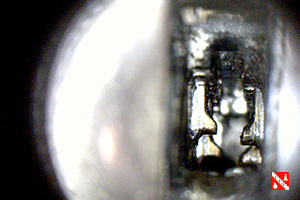
According to the Insurance Information Institute, a motor vehicle was stolen in the U.S. every 45 seconds in 2013. These thefts account for more than $4.1 billion dollars. However, not all of these reported thefts were actually committed by a person not known to the owner. The first person law enforcement generally has to rule out is the owner of the car; they must determine that fraud is not involved.
The field of forensic locksmithing is being used by insurance companies, law enforcement and others in cases relating to break in, cargo theft and vehicle theft. The duties of a forensic locksmith go beyond the lock mechanism itself. The question often asked by these clients is how was entry gained or how was a vehicle driven without the use of a properly cut and, if equipped, transponder-coded key? The science of tool mark identification has been used for many years by organizations such as the FBI, the ATF and CIA. A forensic locksmith will use these same disciplines to identify the means of defeat.
A means of entry needs to be determined first. On a structure, the windows, walls and roof will have to be examined for signs of forced entry if the door lock(s) were not defeated. If the structure was protected by an alarm system, how was the system neutralized? Who had access to, and knowledge of, the alarm system?
A vehicle examination relating to a reported theft is more complicated. A mode of entry should be determined. The windows and seals, door jambs and exterior locks must be examined for tool marks left behind from a defeat attempt. Some means of defeat are obvious, such as bolt cutters being used on a hasp or drilling into a lock plug. Other means used to defeat the lock require the dissection of the lock and closer microscopic examination of the device to identify the tool marks left behind from an individual using a pick, rake, pick gun or jiggle key to name a few. Watch this short video to see how we see inside the car lock.
Knowledge of the vehicle and its security features is a must to determine what actions would be required to take the vehicle without the use of a key. Vehicle security features consist of, but are not limited to, exterior door locks, remote keyless entry systems, transmission shift lock (electric or mechanical), steering lock (electric or mechanical), infrared motion sensors, tilt sensors, ignition lock and transponder-based engine inhibit systems.To defeat a lock, all of the locking components (pins or wafers) holding the device in a locked position must be defeated. Once the locking components have been defeated, the lock plug (where you insert the key) can then be turned to release the lock.
A tool used within a lock keyway leaves an imprint of its actions on the sides of the keyway or on exposed surfaces of the pin or wafer. A forensic locksmith will have the basic knowledge of how a particular lock they are examining is designed and how it operates. This knowledge will assist the investigator in determining how, or if, the lock was defeated.
To steal the vehicle without the use of a tow truck, entry must be gained and the content alarm system (if equipped) must be neutralized. A thief would have to be familiar with the particular anti-theft system on the vehicle they are attempting to steal. The transmission shift lock would need to be disabled either by accessing the shift lock override, if equipped, or by manipulating the switch or cable at the ignition lock. The steering lock would have to be disabled either by manipulation of the ignition lock or by physically removing the lock bar which holds the steering shaft in the locked position. The physical attack on the steering lock mechanism results in extensive steering column damage.
To start the engine, the ignition switch needs to be activated. This is accomplished by either removing the switch from the ignition lock housing and rotating the switch drive to the on and start position, or by defeating the ignition lock pins or wafers and rotating the lock plug to the on and start position. If a thief is successful in defeating the ignition lock, the transponder-based engine inhibit system needs to be addressed. Vehicles equipped with this type of system have a transponder chip, programmed to the vehicle, encased in the key bow or in the fobik. There are millions of code possibilities for the vehicle, but only one will allow the engine control module to start the engine. All of the security features in place to prevent starting, steering and shifting of the vehicle must be defeated to drive the vehicle without a properly cut and transponder-coded key.
Too many claims are being paid out by insurance companies over the illusion of ignition lock or door lock defeat. It is time to take that “closer look” and have a trained and experienced forensic locksmith provide the facts to justify the claim. If you have questions about the science behind this process, please feel free to leave a comment or visit us at http://www.uis-usa.com/.
Mike McGee, CFI, CFEI, ASE, Forensic Locksmith
Unified Investigations & Sciences, Inc., a Sedgwick company